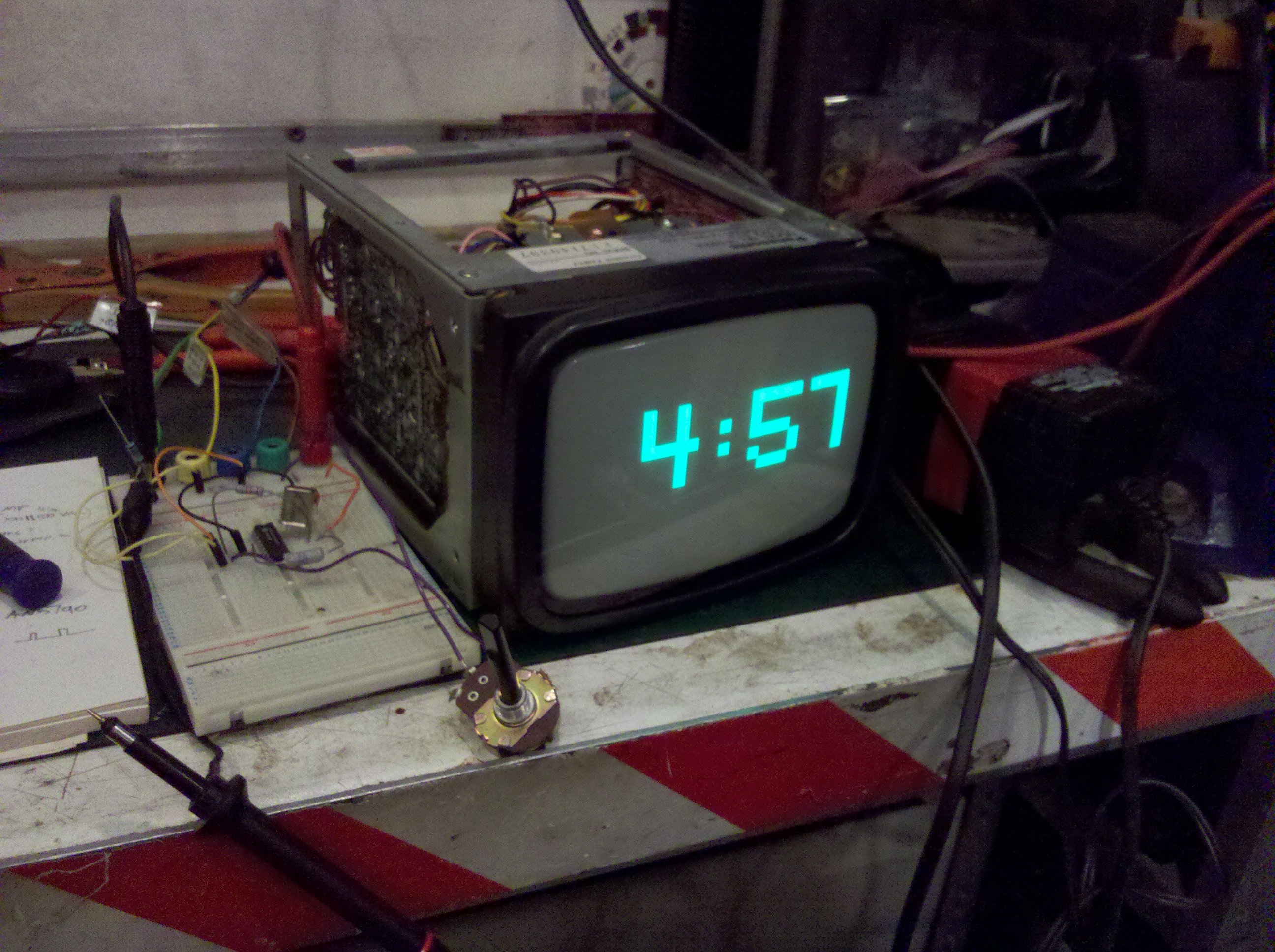OT: How to convert composite video into TTL?
jb-electronics
This is a bit of an off-topic question, but I hope there will be
somebody here that can help. I have bought a new-old stock monochrome
CRT for a HP Agilent 8920A, basically this unit here:
https://www.ebay.com/itm/273930914548 .
It looks to me that it is just a rebranded OmniVision 6" display:
http://www.omnivisionusa.com/Industrial-LCD-CRT-Monitors/replacement-crt/crt-monitors/6-inch-kit-.html
Now unfortunately it takes TTL video as input. But I have a composite
source (a Raspberry Pi). How can I convert composite into TTL? I
basically need to extract Hsync and Vsync and feed it separately to the
unit, okay. There is an old circuit here that does just that:
https://www.elektormagazine.com/magazine/elektor-198812/47485
But I know there are also dedicated chips, like the GS1881:
https://www.mouser.com/datasheet/2/761/GS1881_GS4881_GS4981_Datasheet-769183.pdf
So basically here is my question: before I dive into this any further,
is there any chance of success? What is the optimal choice? Or is it
quite unlikely that I will be able to convert the signals? I mean, even
if I manage to extract Hsync and Vsync, is it likely to work?
I am sorry for the naive question, but I am no expert on video signals,
and it would be nice if anybody more experienced could chime in with a
few words of caution/experience.
Best wishes
Jens
Adrian Godwin
--
You received this message because you are subscribed to the Google Groups "neonixie-l" group.
To unsubscribe from this group and stop receiving emails from it, send an email to neonixie-l+...@googlegroups.com.
To view this discussion on the web, visit https://groups.google.com/d/msgid/neonixie-l/e0f398e8-24b1-952c-c998-0ddfbed6849e%40jb-electronics.de.
Alex

jb-electronics

To view this discussion on the web, visit https://groups.google.com/d/msgid/neonixie-l/CALiMYrvHCiXd3QSDmEJ%2Bpe3XgUutOC_C3yLFGxeOEo2bjtEAWw%40mail.gmail.com.
jb-electronics

To view this discussion on the web, visit https://groups.google.com/d/msgid/neonixie-l/CALiMYrvHCiXd3QSDmEJ%2Bpe3XgUutOC_C3yLFGxeOEo2bjtEAWw%40mail.gmail.com.
David Forbes
To view this discussion on the web, visit https://groups.google.com/d/msgid/neonixie-l/0b6843bf-8882-8a17-7c62-437ffc98a5ff%40jb-electronics.de.
chuckrr
David, How come you never answer any of my questions about the rubidium oscillator? I have asked you about it many, many times and have never
received any response from you. -Chuck
To view this discussion on the web, visit https://groups.google.com/d/msgid/neonixie-l/CAPbqtvdWTmhDEjMoQQvcS%2BBROe64k3S%3Dy9_g2%2Bn%2B_ACQDVyHJg%40mail.gmail.com.
5-ht
Mac Doktor
On Apr 10, 2021, at 3:53 PM, David Forbes <nixie...@gmail.com> wrote:I built a couple LED TV sets about ten years ago. I had to solve this problem. I bought a sync separator chip for the first one, and a digitizer chip for the other.See the bottom of the page for schematics.
"The Mac Doctor"
jb-electronics
To view this discussion on the web, visit https://groups.google.com/d/msgid/neonixie-l/a3fe30c7-c778-444a-a745-b6f6b1910bb1n%40googlegroups.com.
Adrian Godwin
To view this discussion on the web, visit https://groups.google.com/d/msgid/neonixie-l/37bf74f3-842f-2d17-c5b7-0606f09d9d4e%40jb-electronics.de.
gregebert
jb-electronics
To view this discussion on the web, visit https://groups.google.com/d/msgid/neonixie-l/CALiMYru71Senz_sdSjFuWJMenZCgkRLyX%3DM%3D73kzP2TCveg6%2BA%40mail.gmail.com.
jb-electronics
To view this discussion on the web, visit https://groups.google.com/d/msgid/neonixie-l/265e64ca-0d77-42da-9788-c5671f22d4f7n%40googlegroups.com.
Adrian Godwin
To view this discussion on the web, visit https://groups.google.com/d/msgid/neonixie-l/e49bca6f-fc9e-e4ee-9003-ccd950ce1d82%40jb-electronics.de.
Robert G. Schaffrath
Adrian Godwin
locking on). NTSC (Never Twice the Same Color) was a bit of an issue with needing Color and Hue controls that adjusted the TV's
Charles MacDonald
> To complete the trio : SECAM is Something Essentialy Contrary to the
the early sets would have needed extra circuitry to decode the
alternating lines. BUT the explanation at th etime was that microwave
inter station transmission in Europe had not been built with colour in
mind and PAL had sufficient error correction built in that it did not
matter.
--
Charles MacDonald VA3CPY Stittsville Ontario
cm...@zeusprune.ca Just Beyond the Fringe
No Microsoft Products were used in sending this e-mail.
John Rehwinkel
- John
Robert G. Schaffrath
gregebert
jb-electronics
I am looking for a 5"-6" monochrome CRT, preferable green or amber, with
composite video input. If anybody has one for sale, please let me know!
Best wishes
Jens
Mac Doktor
On Apr 13, 2021, at 2:09 PM, Robert G. Schaffrath <robert.s...@gmail.com> wrote:Big problem these days is where to get an NTSC video source. The only things I currently have left are an old 8mm camcorder and a digital to NTSC converter box that were common when the US went all digital.
"The Mac Doctor"
Adrian Godwin
--
You received this message because you are subscribed to the Google Groups "neonixie-l" group.
To unsubscribe from this group and stop receiving emails from it, send an email to neonixie-l+...@googlegroups.com.
To view this discussion on the web, visit https://groups.google.com/d/msgid/neonixie-l/26bb430c-025f-f3c4-34d2-42db16b2dbf1%40jb-electronics.de.
jb-electronics
To view this discussion on the web, visit https://groups.google.com/d/msgid/neonixie-l/CALiMYrsgDiWe_-kYsz3HuCxcgSsVnGY7VRL6bZ7t6HMuju8XxQ%40mail.gmail.com.
Adrian Godwin
To view this discussion on the web, visit https://groups.google.com/d/msgid/neonixie-l/abc536e3-c2f5-7a6a-0696-b70153f0106b%40jb-electronics.de.
Toby Thain
> No, they often have a Z modulation input and many have a TV sync, so
> you'd only need to add a vertical scan. But tube depth is a problem.
> Green isn't, though !
>
> On Wed, Apr 14, 2021 at 2:44 PM jb-electronics
> <webm...@jb-electronics.de <mailto:webm...@jb-electronics.de>> wrote:
>
> It's a good idea, but these scope tubes are too deep and don't have
> a composite input usually (but x/y deflection setup). I am trying to
> build a luggable computer (think Osborne I).
>
> Jens
>
supporting circuitry. This one is 6 x 4.5cm, white phosphor, magnetic
deflection, and some are sold with the TV frequency yoke.
https://www.ebay.ca/itm/8LK3B-vintage-CRT-tube-3-6-cm-x-4-5cm-USSR-Soviet-Oscilloscope-NEW/254462273192
(A friend and I are trying to integrate this tube at the moment.)
--Toby
jb-electronics
- As mentioned before, the screen coverage is a bit poor (lots of space to the left and right).
- The brightness is rather low (what is full brightness at TTL? Probably 5V? Composite maxes out way below that, so maybe I should hook up an amplifier?)
So here is the schematic of a very similar module: http://oz1db.dk/hp/omnivision_man_lp06xx_rev0_0611.pdf . Can't I just change the timing capacitors for the horizontal and vertical sync? (I.e. mess with R17 at U1 and R35 at U2)? Based on what Adrian wrote below it seems it might be possible, within reason? Since it is already working (kind of, limited screen coverage) I probably don't ahve to tweak much?
So if anybody can help on the brightness issue as well as on
the frequency modification I would be very grateful!
To view this discussion on the web, visit https://groups.google.com/d/msgid/neonixie-l/CALiMYrs0B6JC_i09SwUa2rPxmrV4%3D5g3RF2mt2-wUZJAtiUW4w%40mail.gmail.com.
Adrian Godwin
To view this discussion on the web, visit https://groups.google.com/d/msgid/neonixie-l/5a7d7063-5c00-2fc2-3fd7-eaeba8333662%40jb-electronics.de.
